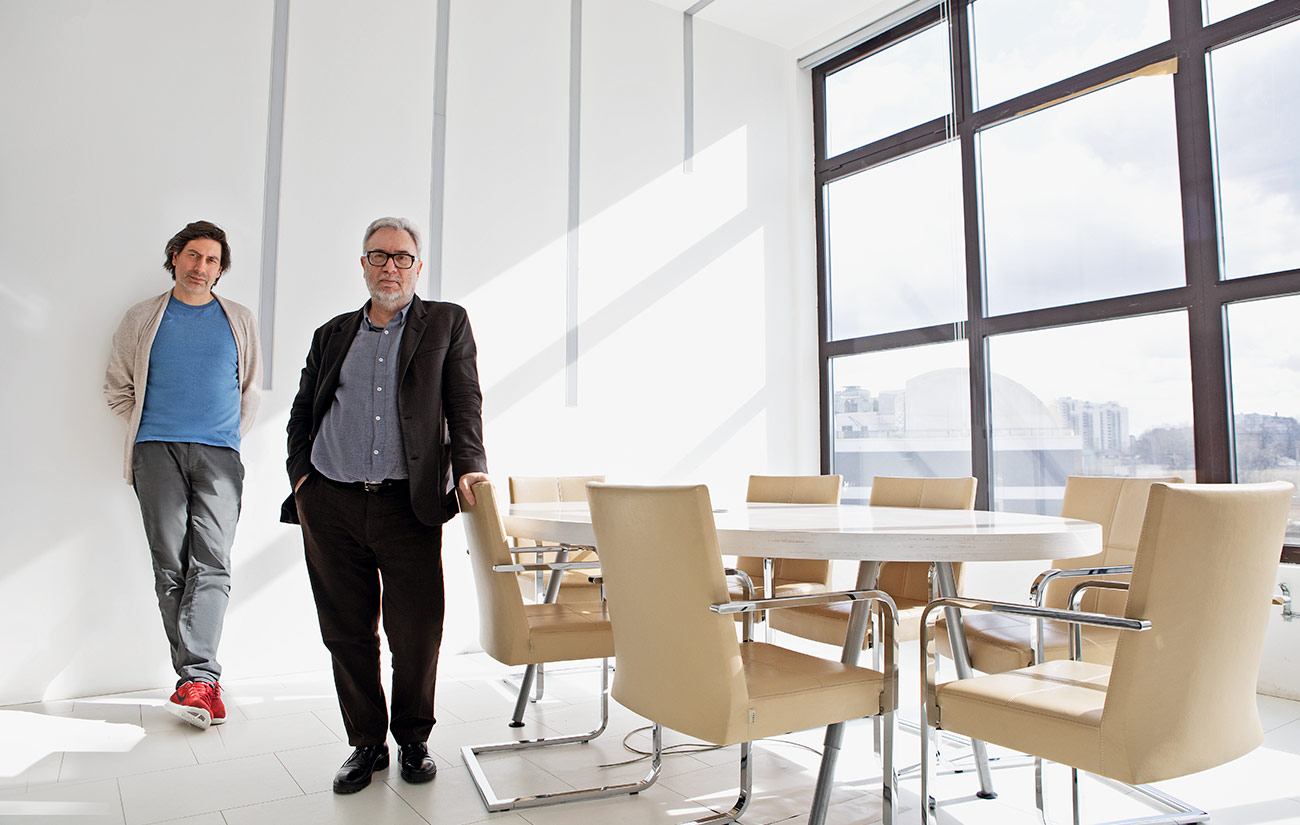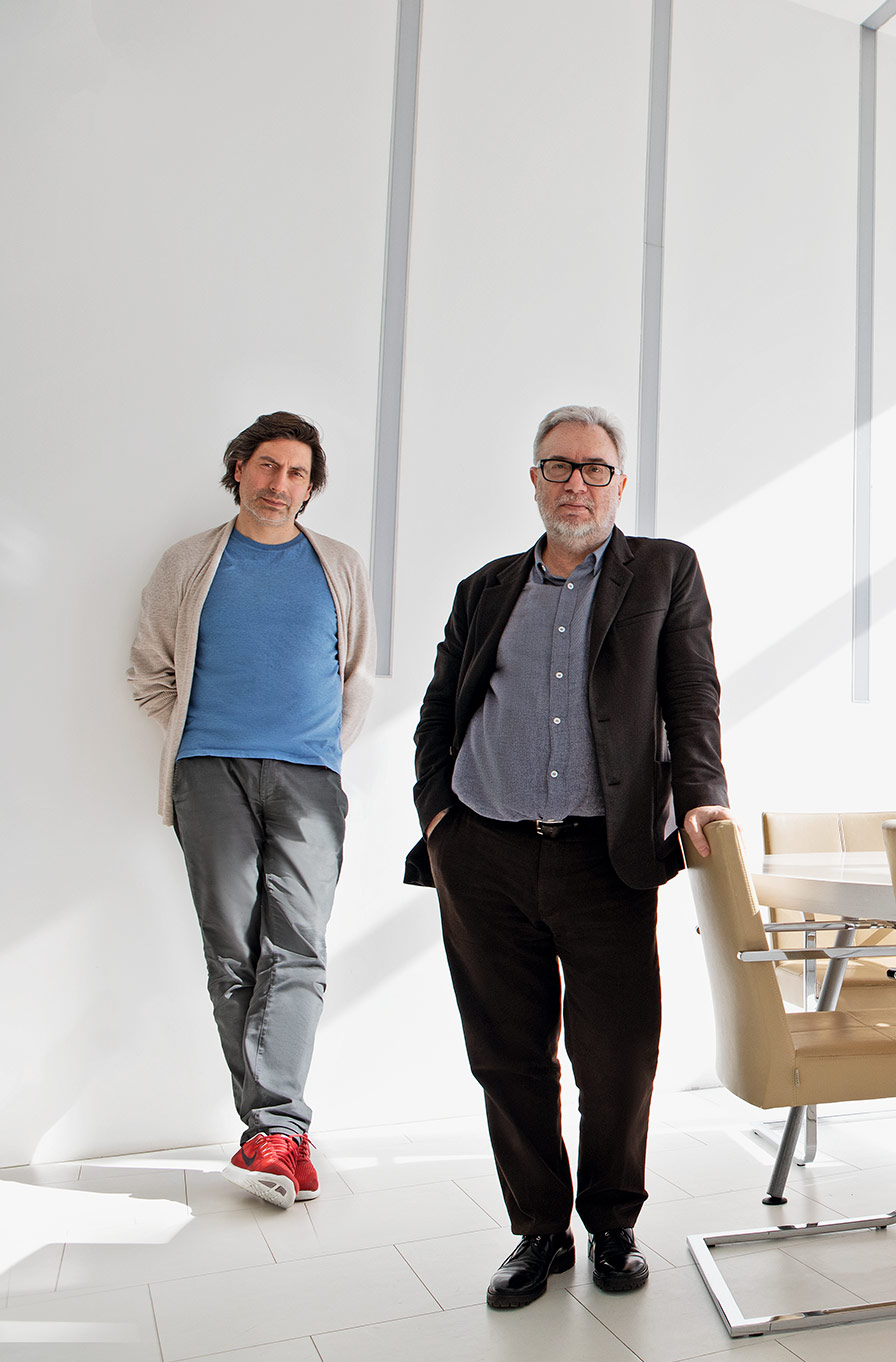
Red on Black
The idea of the GUM-Red-Line Art Show was finalized when the name of the project and its architectural design developed by
the Wowhaus Architecture Bureau came together. The Wowhaus Architecture Bureau, founded by architects Dmitry Likin and Oleg Shapiro, is well known for its significant and instantly recognizable projects, such as the Stanislavsky Electric Theater, the Documentary Film Center, the Praktika Theater, the Olive Tree Beach at Gorky Park, Strelka, the Ice Skating Rink at Sokolniki, the Palisander Gallery, as well as numerous installations in parks and public spaces, 2017 New Year decorations at GUM, a fireworks festival, Moscow On Seven Hills installations, and many other pieces.
A quote from the Wowhaus manifesto: “Any object, building, or space bears a message from its author. Nevertheless, architecture is not declarative anymore; it has to consider the multiplicity of possible solutions.” The series of pavilions designed by Wowhaus for the GUM-Red-Line Project is an architectural vision of the concept that was proposed by each artist participating in the festival. In other words, it is a collaboration between the artists and the architects. Sometimes the artists’ ideas were difficult to express through architecture; at times art and architecture formed a natural harmony. Creating an interactive information board with video interviews and pavilion concept descriptions became an additional task for the architects. Eventually, Oleg Shapiro and Dmitry Likin along with the bureau’s architect Katerina Kovbashina adapted all of the 15 projects into a coherent concept and presented the artists in a concise way, both clearly and comprehensively.
The exhibition’s curator Marina Fedorovskaya finds out more about the ideas behind the initial concept and its transformation towards the final solution.
Marina Fedorovskaya (MF): You had quite an eloquent color solution for the project – red for the external walls, and dark grey for the internal walls. It is difficult to avoid clichéd associations: colors of the Russian avant-garde, the revolution... The list goes on.
Oleg Shapiro (OS): I believe that it is not as complicated as that. It’s a reflection of the Red Square.
Dmitry Likin (DL): I feel the same. It is crucial not to invent any extra stuff, we are working as an architectural bureau in this project. Some general and conceptual solutions form a background for the artworks. As for the messages – all these artists have their own personal brands, so, in my opinion, you were completely right in selecting these artists. Other institutions deal with young artists. Your selection is entirely representative.
MF: You are right. We did want to show the most renowned artists from the world of contemporary art. The latter somehow remains hidden from the general public. They represent different generations from the last 30 years. There is no wonder that we called our project One Family. First of all, it is a sort of conglomeration of the contemporary Russian artists, and secondly, there are parents, and kids, and grandparents among these people.
DL: One should note that a part of the project has more to do with modern art, while another part can be attributed to contemporary art, but all in all, it is contemporary art.
MF: All the artists taking part in the festival at different times created the very concept of contemporaneity; they were filling a void in the wall of misunderstanding. Most of them are already a part of art history as famous artists, and we are just providing a platform to tell their stories to the audience. It goes without saying that we have done this with your help.
OS: We are here in support of the idea of presenting contemporary art in a particular space. Both people who are familiar with contemporary art and people who are still getting to know it are welcome to visit the exhibition. We have already done a similar project at Vyksa and other cities as well, and such work constitutes quite a significant part of our activities, we do popularize the concept of contemporaneity in public spaces. But in these circumstances, we have decided to view the GUM-Red-Line Project almost as a story on par with such religious texts, as the Bible. We can refer to the image of merchants in a temple. The temple here (if we are considering art) is a department store. It was one of our primary tasks to separate the “art temple” from the “shopping temple.”
DL: We had the following idea: to create structure similar to containers one uses for musical instruments. This sequence – “trunk – case – shelter” – brought us to the concept of a “shell”. In English, it is a word that can be used to describe many things. A literal shell, armor, a case. It is a graphical structure that contains a particular significant area that is deliberately taking us out of our context and creating a new context. As we had established the idea of a thematic “red line”, we figured that we should collect a certain amount of these shells that could be presented here. Initially, all of us associated the word “shell” with a garage shell that one could find in Russian courtyards and where Russians kept their first cars. So, our first idea was to create a space consisting of such dynamic opening shells.
MF: Yeah, and that would have been your total installation! The artists would not matter here that much.
DL: That is the point! So, we decided to pass on it: such a project would be too declarative, too self-sufficient for us. In reality, we were asked to discretely express ourselves by showcasing the artists.
MF: Right. There is always a silent war between magazine editors and designers or curators and architects in art projects. Recently Victor Misiano at the Moscow Museum of Modern Art Curator School, where I am studying and teaching at the same time, shared with the audience the idea about how difficult it is to find a right architect for art-projects. So, I immediately thought about you. I am thrilled that you are always thinking of the artists.
OS: It is imperative to explain that it was vital for us to separate the exhibition content from the intense commercial space around us. There is lots of stuff around here – shop windows, arches, glamour...
DL: At first, we were thinking about white structures, a traditional exhibition space. Later, we figured out that they wouldn’t work here since they would be overwhelmed by their surroundings. White walls are great in a gallery, in a secluded space. Consequently, we came to the concepts of a shell and a jewelry case with a black velvet inlay. We decided to make such a display to showcase each artist, ensuring that their artworks could be separated from the various outside noises. This helps separate them and shelter them. There is no other idea behind this.
MF: The integration of contemporary art in grand commercial spaces is the main trend of the last 20 year. It is a period when art is getting out of galleries and forwardly addressing its audience, since the fashion crowd is susceptible to the fresh ideas of contemporary art. I think that GUM-Red-Line is one of the most large-scale projects of this kind. A project involving fifteen artists and running for one month and a half seems unprecedented to me. As far as I can see it, your task was to create structures that wouldn’t be swept off by the thousands of visitors at GUM.
OS: We do work with contemporary art in open spaces, just like the project in the small town of Vyksa, and in other places as well. Still, an audience of 50 thousand people is not as much as a city with 14 million inhabitants.
DL: I am also in awe of the GUM-Red-Line Project since it is aimed at art neophytes, so, to a certain extent, it is fearless. In the last three years, I have been playing around with some ambitions to popularize art, not that they were inherent to me, at Polytech and within a specific workgroup that develops meanings. Alongside many of my friends, I work on numerous popular projects, such as Arzamas, for instance. I’ve started to understand that these educational projects are focused on a sophisticated audience, while educational projects, pardon me for being banal, are addressed to people unfamiliar with art. The lantern of knowledge should always illuminate darkness.
MF: There is a term “profane audience”, and it is very important for contemporary art since the latter is the one that shutters and expands the borders of such an audience.
DL: There is one more significant story. We were all raised on the Bolshevist concept of art belonging to the people. It was all such a delusion, since not in a single place on Earth does art belong to the people. The people own the culture. But art does not have much to do with the people. It has always been a part of a complicated elite world, a hard endeavor. Moreover, all art at all times requires a specific initial effort from the perceiving mind. No one says that interpreting art is a pleasant activity.
MF: Though the process of democratizing art is very active: there are more and more art festivals, biennales, and so on – they all grow exponentially, there are new museums being built, contemporary art schools are established. All of the above helps to prepare the audience and assist many new artists to stand out of the crowd. As for those people who are not going to become artists, they will form a well-qualified audience for any art.




